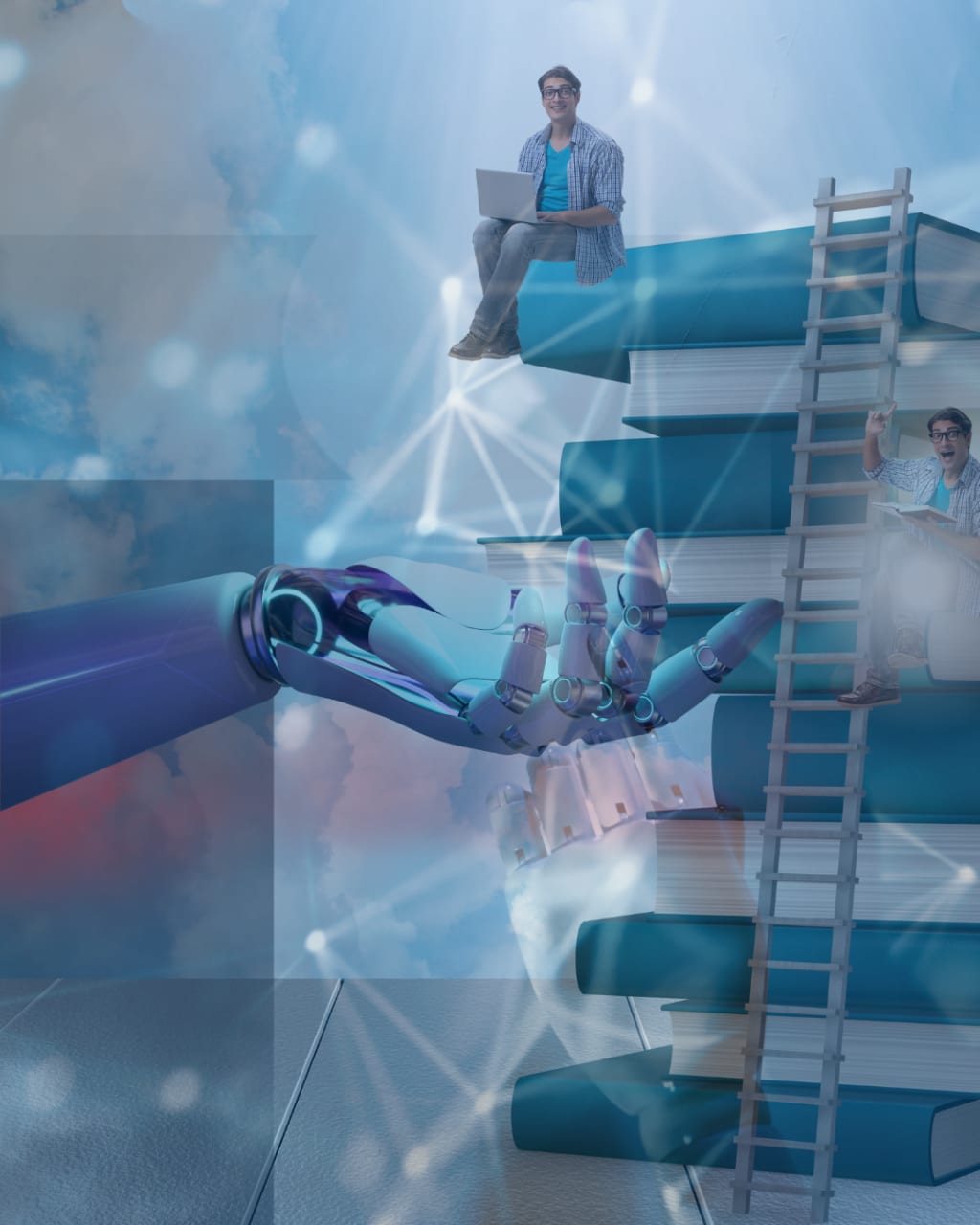Another click in the wall-Education in the Age of AI.
An OP.ed

While Gove and his cronies were fixated on the British literary heritage and shoving the crown prince of it, Will Shakespeare, down the throats of modern youth. And while, on the other side of the pond, they were distracted with banning all books featuring diversity of any kind (in a country piggy backing off the multicultural brand name no less). The distinctly more progressive IT lot have been busy writing the books of the future. With artificial intelligence or AI for short.
So what is this AI of which I hear you speak?
In the context of education AI is essentially state-of-the-art language models which are designed to produce text based on the input it receives from the user (a human). Utilising an immense amount of data, it has the lightning fast ability to answer specific questions, generate content like summaries of novels, assist in research, and even recommend books that you could teach students and why they might be suitable for your specific group (based on personality, demographics, whatever you stipulate). Great right?
Well yes and no. It could be. But as per the norm, education is woefully and embarrassingly slow on the uptake. Particularly given the role it is supposed to play in society…you know… enlightening the masses and all that jazz. The dichotomy is that we should be training students to use the tech responsibly. And to further enhance their knowledge. But the system is not equipped for it. The curriculum has been squeezed to within an inch of its life, there is so little room for manoeuvre of any kind. After all, there are written exams to pass, don’t you know? Lord forbid we should actually teach our kids something real world ready.
Yet, the exam system is fundamentally draconian. It no longer reflects the world in which our students operate, and as a result they will be unequipped for the new opportunities that tech could afford them, if they had been educated in the way they deserve. Business is dynamic. Communication. Problem solving, critical thinking. No one gives two hoots if you ask a chat bot some questions-as long as it makes your output more effective. AKA, makes money. But here we are, doling out paper and pen expecting students to cram and regurgitate an entire essay. In an hour. With no dictionary. Nothing. Just as we have done for decades. Centuries even.
Can you recall a recent time in your job when you didn’t have access to the internet? Couldn’t phone a friend if you needed to? Asked a colleague? Unless of course, you’re a fisher-person and you got shipwrecked.
It’s almost tragic. It is tragic. If aliens are actually watching, they’ll be scratching their heads considerably at our lack of care for our young people and their future. Whilst Elon is zipping around in orbital space, our future generation is reading Othello; spewing out contrived descriptions of, ‘The fairground’. And, rehashing stories that end with the line, ‘I didn’t see it coming’ Yawn. And worse. It really hasn’t changed since I was in school nearly 25 years ago. Except I got ,’Write about your favourite room in the house’’. Thanks WJEC. Innovative.
The solution is clear really, and not wholly unmanageable. But it will never happen. Or at least not in my lifetime. Just let kids use the tech. If they all have access to the same tools, then they still have to know how to use them. Personally, I’d rather employ a youngster who knows how to fact check, can use the AI effectively to produce quality work and can communicate appropriately with my clients. I’d take that over some Shakespeare quoting bore who can write about what the school canteen smells like but can’t engage.
All of that being said, while education, or more specifically the assessment system is unprepared for the phenomenal potential of AI, there are some aspects of it that can be utilised to enrich the lives of teachers and their charges.
One of the most troubling aspects of our modern system is quite simply the volume of students herded into a high school classroom (There is no legal limit but usually around 32 in the UK and whatever the state decides in the US). ‘Got a question…you’ll have to wait for the other 31 to ask theirs first.’ *Bell rings.
Personalised Learning Assistance
One of the primary benefits of AI is its capability to deliver almost instantaneous feedback. Students can pose questions and receive immediate, detailed explanations, they can simply ask the AI model to provide a summary of the topic or conversely, a high ability student feels that the lesson taught wasn’t challenging or deep enough. No problem, they can delve in headfirst thus allowing teachers to maximise learning opportunities and spread their precious interactions with students in a more deliberate way. The days of ‘Miss I’ve finished,’ could be long gone. If only we knew how to use it.
Couldn’t said bright spark just Google it? Not exactly. AI answers your specific question immediately and insightfully. A search engine on the other hand offers a much broader offering. It answers lower order questions well…Who is Queen Elizabeth? Where is it Kuala Lumpur? Try asking a ‘why’ formation. Not nearly so successful. How many times have you been lost trying to search for the information you need? AI can do this in a matter of seconds. And integrate responses with previous information.
Let’s say you ask it, “Why is the earth round?” for example, as I literally just did. This is what you will get or at least if you ask ChatGpt,
‘The statement “the world is round” is a simplification. In fact, Earth is not a perfect sphere but rather an oblate spheroid, meaning it’s slightly flattened at the poles and bulging at the equator. The reasons for this shape can be traced back to two primary forces:
Gravitational Forces: When the Earth was forming billions of years ago, matter began to clump together under the force of gravity. As more and more matter accumulated, the force of gravity grew stronger and pulled everything toward a common center, forming a spherical shape. A sphere is the geometric shape where all points on the surface are equidistant from the center, and this configuration minimizes the gravitational potential energy of the planet.
Rotational Forces: As the Earth rotates around its axis, centrifugal forces (outward forces due to rotation) act on it. These forces are strongest at the equator and weakest at the poles, causing Earth to bulge out slightly at the equator. This is why Earth is not a perfect sphere but an oblate spheroid.
The combination of gravity, which pulls everything into the most energy-efficient shape (a sphere), and Earth’s rotation, which causes a slight bulging effect at the equator, results in our planet’s distinctive shape.’’
(Not my own work. This is AI generated for illustrative purposes only)
Now Google, or Bing or Yahoo, whatever your search pal of choice, won’t do that. Can’t do that. They simply search for exactly what you ask them.
Homework and Research Help
Students often struggle with homework without a teacher or peers on hand for support. And for the most part, parents are often flummoxed by the math equations set and they probably haven’t read, Hamlet since they were in school. AI can guide them through complex topics, offer insights, and even suggest resources. Of course, the downside to this is obviously the lack of independent ‘doing’ as it were. But, even before the likes of ChatGpt materialised, the ‘phone a friend’ option existed. At least this way they might actually get the answers right.
Language Learning
For students learning a new language, AI archetypes can function as a ‘‘lingo- bud’’, rectifying grammatical inaccuracies and augmenting vocabulary. Though less effective with whole paragraph translation, it can act as an aide in the process of acquiring another language. Something the embarrassingly insular Brits would do well to explore in more depth.
Assisting Educators
I am not afraid to admit, ChatGpt, my current preferred model of AI has very quickly become a staple in my working life and has saved me countless hours. I’ve even managed to do a tonne of jobs, that I have always wanted to do but simply didn’t have time. Like write model essay plans for specific A Level language questions (A quick 10 second prompt), collate all of the past paper ‘Cambridge General English’ questions into themes (ctrl x…ctrl v). and make gap fills based on a text (Another copy and paste job).
Of course, it’s not perfect and these things still need to be checked properly for inaccuracies. But checking takes a lot less time than starting from scratch. I am fully aware that I have only seen the tip of the iceberg of how this invention can make me more productive and indeed a better educator, and I’m quite excited to find out what else it can do!
Very obviously, I am a bit of a fan and so far it’s been all been scented with roses but there are of course more than a few thorns, or rather, this one’s for you Gove, ‘’flies in the ointment.’’
There are some definite pitfalls.
Over-reliance
There’s a risk of students becoming overly dependent on AI for answers which has the distinct potential of thwarting critical thinking and problem-solving skills. The exact opposite of what I advocated earlier that such models could foster. But is, as always, about balance.
Data Privacy: Think Facebook–Cambridge Analytica. Mark 2. Ensuring that interactions with the tech remain secure and aren’t exploited is fundamental.
The socio-economics.
In this unbalanced world we inhabit; all might be fair in love and war but it is distinctly not so in education. In my current school, private international, students and teachers all have IPADS, but in other schools I have worked, neither private nor international, teens would be lucky to get breakfast, let alone a device to do their homework on. If we are not vigilant we could find the gap between rich and poor growing ever greater than the vast expanse it already is.
In conclusion, while AI offers a cornucopia of opportunities to transform the way we educate, we are limited in our ability to chow down into them. We need to consider the potential benefits with the obvious weaknesses thoughtfully and carefully.
Ultimately, the truth is, whether we embrace it or not. Our kids certainly will. So, why not welcome it? Not with open arms, but with a wary pat on the shoulder, at least for now.
The bottom line is, it’s not the technology itself but how we use it that will define our future. AI is not a crutch and was never meant to be, if we use it as such. we risk stunting our growth. However, if we embrace it as a catalyst, the potential for innovation and progress is infinite. We could do so much more if only our governments could see it.
About the Creator
Enjoyed the story? Support the Creator.
Subscribe for free to receive all their stories in your feed. You could also pledge your support or give them a one-off tip, letting them know you appreciate their work.
Reader insights
Nice work
Very well written. Keep up the good work!
Top insights
Easy to read and follow
Well-structured & engaging content
Eye opening
Niche topic & fresh perspectives
Masterful proofreading
Zero grammar & spelling mistakes
On-point and relevant
Writing reflected the title & theme





Comments (2)
Test is not accepting comments at the moment
Want to show your support? Send them a one-off tip.